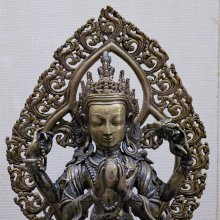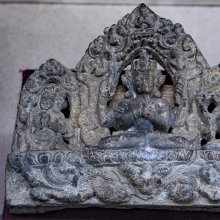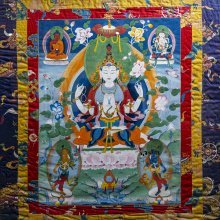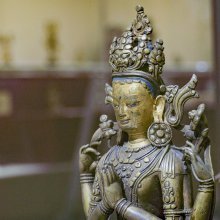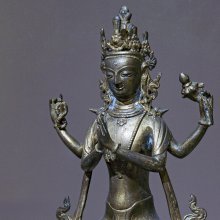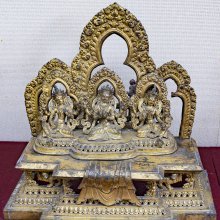Shadakshari, Ṣaḍakṣarī, Shad-akshari: 3 definitions
Introduction:
Shadakshari means something in Buddhism, Pali, Hinduism, Sanskrit. If you want to know the exact meaning, history, etymology or English translation of this term then check out the descriptions on this page. Add your comment or reference to a book if you want to contribute to this summary article.
The Sanskrit term Ṣaḍakṣarī can be transliterated into English as Sadaksari or Shadakshari, using the IAST transliteration scheme (?).
Images (photo gallery)
(+15 more images available)
In Buddhism
Tibetan Buddhism (Vajrayana or tantric Buddhism)
Source: archive.org: The Indian Buddhist Iconography1) Ṣaḍakṣarī (षडक्षरी) or Ṣaḍakṣarīlokeśvara refers to one of the various forms of Avalokiteśvara having their Sādhana described in the 5th-century Sādhanamālā (a collection of sādhana texts that contain detailed instructions for rituals).—His Colour is white; his Mudrā is the añjali; his Symbols are the rosary and the lotus; his Companions are Maṇidhara and Ṣaḍakṣarīmahāvidyā; he has four arms.
The Dhyāna (meditation instructions) of Ṣaḍakṣarī is described in the Sādhanamālā as follows:
“The worshipper should think himself as [Ṣaḍakṣarī] Lokeśvara who is decked in all sorts of ornaments, white in colour, and four-armed, carrying the lotus in the left hand and the rosary in the right. The other two hands are joined in forming the mudrā of clasped hand against the chest. To his right is Maṇidharā, with the same colour and the same hands, sitting on another lotus. To the left is Ṣaḍakṣarī-Mahāvidyā with identical form sitting on another lotus”.
[The Dhyāna of this god has been extracted from the Kāraṇḍavyūha according to a statement in one of the colophons of the Sādhanas. The Mantra assigned to this form of Avalokiteśvara is the famous “Oṃ Maṇipadme Hūṃ” consisting of six syllables which are here deified in the form of Ṣaḍakṣarī Mahāvidyā. When Lokeśvara is associated with the Great Knowledge of the Six Syllables, he is called Ṣaḍakṣarī Lokeśvara.]
When he appears in a group of two in the company of Sadaksari Mahavidya, the goddess may have another form depicting her in Vīrāsana with yellow colour and two hands. Her right hand remains empty, while the left holds the jewel. The Sarnath Museum image (Fig. 98) although mutilated, must represent this form of Ṣaḍakṣarī Mahāvidyā who can be readily recognised by the peculiar Āsana which is uncommon in Buddhist iconography. [...] Another alternative is also prescribed in the Sādhanamālā for all the three deities, and the Sādhana adds: “'Sometimes in the Sādhana of Ṣaḍakṣarī Mahāvidyā, Lokeśvara holds also the lotus bearing the jewel and the book, Maṇidhara may hold the jewel and the lotus but should be without the book. Ṣaḍakṣarī may hold the book and the lotus but should not have the jewel”.
2) Ṣaḍakṣarī (षडक्षरी) or Ṣaḍakṣarīlokeśvara refers to number 6 of the 108 forms of Avalokiteśvara found in the Machhandar Vahal (Kathmanu, Nepal). [Machhandar or Machandar is another name for for Matsyendra.].
Accordingly,—
“Ṣaḍakṇarī sits in the Vajraparyaṅka attitude. He has four arms and one face. The principal pair of hands is joined against the chest in forming the Añjali. The second pair carries the rosary in the right and the lotus in the left”.
The names of the 108 deities [viz., Ṣaḍakṇarī] possbily originate from a Tantra included in the Kagyur which is named “the 108 names of Avalokiteshvara”, however it is not yet certain that this is the source for the Nepali descriptions.

Tibetan Buddhism includes schools such as Nyingma, Kadampa, Kagyu and Gelug. Their primary canon of literature is divided in two broad categories: The Kangyur, which consists of Buddha’s words, and the Tengyur, which includes commentaries from various sources. Esotericism and tantra techniques (vajrayāna) are collected indepently.
Languages of India and abroad
Sanskrit dictionary
Source: Cologne Digital Sanskrit Dictionaries: Edgerton Buddhist Hybrid Sanskrit DictionaryṢaḍakṣarī (षडक्षरी).—(1) name of a magic formula of six syllables (om maṇi padme hūṃ, Kāraṇḍavvūha 76.6): Kāraṇḍavvūha 67.3 ff.; 74.15 etc.; 76.4 etc.; (2) name of a rākṣasī: Mahā-Māyūrī 243.29.
Sanskrit, also spelled संस्कृतम् (saṃskṛtam), is an ancient language of India commonly seen as the grandmother of the Indo-European language family (even English!). Closely allied with Prakrit and Pali, Sanskrit is more exhaustive in both grammar and terms and has the most extensive collection of literature in the world, greatly surpassing its sister-languages Greek and Latin.
Kannada-English dictionary
Source: Alar: Kannada-English corpusṢaḍakṣari (ಷಡಕ್ಷರಿ):—[noun] the sacred hymn " Ōm namaśśivāya ".
Kannada is a Dravidian language (as opposed to the Indo-European language family) mainly spoken in the southwestern region of India.
See also (Relevant definitions)
Partial matches: Akshari, Shash, Sat.
Starts with: Shadaksharideva, Shadaksharika, Shadaksharilokeshvara, Shadaksharinyasa, Shadaksharistotra.
Ends with: Suryashadakshari.
Full-text: Suryashadakshari, Shadaksharideva, Shadaksharilokeshvara, Om.
Relevant text
Search found 4 books and stories containing Shadakshari, Ṣaḍakṣarī, Shad-akshari, Ṣaḍ-akṣarī, Sadaksari, Sad-aksari, Ṣaḍakṣari; (plurals include: Shadaksharis, Ṣaḍakṣarīs, aksharis, akṣarīs, Sadaksaris, aksaris, Ṣaḍakṣaris). You can also click to the full overview containing English textual excerpts. Below are direct links for the most relevant articles:
The Indian Buddhist Iconography (by Benoytosh Bhattachacharyya)
Sripura (Archaeological Survey) (by Bikash Chandra Pradhan)
Scultures of Sadaksari-Lokesvara < [Chapter 3 - Sculptural Programme]
Scultures of Bodhisattvas < [Chapter 3 - Sculptural Programme]
Bronze-icons < [Chapter 3 - Sculptural Programme]
Stupas in Orissa (Study) (by Meenakshi Chauley)
Minor Votive Stupas at Ratnagiri < [Chapter 4]
Related products
